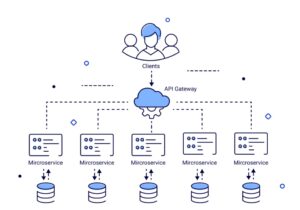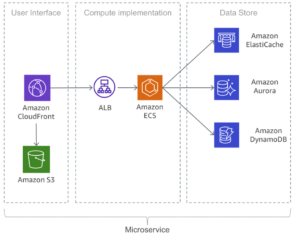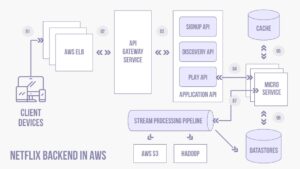Today, nearly 63% of enterprises worldwide have adopted micro-services architecture. It has been widely embraced because of the modular approach (instead of monolithic) for software development that enables the rapid, frequent, and reliable delivery of large and complex applications.

Micro-services architecture. Source: Middleware
1. Overview on micro-services
According to Fortunesoft report, ” as per the stars by Maker Search Future, the micro-services architecture adoption is forecasted to be USD 33 billions by 2023 with a CARG of 17%. Organizations have been able to deploy different teams to work in a decoupled manner on various services independently to create an application that works as a collection of services. Now applications can use an evolved technology stack to create a highly maintainable, testable, and scalable application organized around business capabilities.

Micro-services Architecture Market Adoption from 2016 to 2023. Source: Fortunesoft
2. Modernizing & Refactoring Legacy Applications
To be future-ready and agile with the evolving technologies, it is essential for businesses to move from legacy to modern platforms. To ensure a strong and modern IT infrastructure is built, refactoring it with micro-services that allows you to deploy full-stack development technologies.

There are giants industry showed the best micro-services use cases. Source: Alpacked
3. Big Data Application
Micro-services, coupled with Event-Driven Architecture (EDA), is a natural fit for complex applications and cloud environments in many cases. It provides the scalability and extensibility to the required application because of it is loosely coupled architecture.
In its own application deployment, Amazon simplified its pipeline, uncovered problem areas, and rebuilt a robust application framework while introducing a solid open source system to cater to the huge volume of data processing. The service-oriented micro-services architecture optimally supported every function across the globe.

Micro-services Architecture of AWS. Source: Amazon
Growing traffic was overwhelming for eBay; however, it was becoming difficult for the systems to handle the complexities of growth. To cater to 75 billion database calls in a day, eBay decided to divide the application, database, and even search engines by adopting the micro-services architecture. Since the technology was first introduced, constant and timely updates have kept the company website stable while boosting its time-to-market rate.
4. Real-time Data Processing
The publish-subscribe messaging pattern used in micro-services architecture enables a seamless asynchronous communication to process and analyze data in real-time for streaming platforms to generate intelligent outputs.
It takes more than 500 micro-services and API’s to deliver a product as refined as Netflix, an over-the-top content platform and production company. And as an early adopter making it an engrossing case study that focuses on the many benefits of micro-services.

Micro-services Architecture of Netflix. Source: TechAhead
Organizations that capture high-volume unstructured data such as social media networks like Twitter need to be scalable and at the same time flexible. Micro-services make it seamless to identify roadblocks and enable faster deployments. Twitter moved from the traditional web application to the micro-services architecture using Scala and Java.
5. Multi-group Developments
To meet frequent release timelines, multiple developers working on the same piece of an application’s feature is how the software development space is building up. To cut down scenarios of the code succumbing on the ‘merge day’, micro-services architectures enable applications to be split up into independent services, to be able to be managed and plugged in together by individual groups.
6. The DevOps Model
DevOps and micro-services work flawlessly when applied together. Micro-services improve the productivity of the DevOps team by embracing a common toolset that can be used for both development and operations. This enables a common terminology and processes for project requirements, task dependencies, and challenges. Now Developers and Ops people can work jointly on a problem and successfully fix a build configuration or build script.
Coca-Cola made an early decision to adopt micro-services. This structure is divided into a single app via which they are able to address any speed or agility related issue. Added to this, they created Anytime Platform – a set of reusable modules accessible by every business entity in the group.
Other than the above, applications that are used across multiple channels such as notification, login service, travel, and hospitality booking services (such as Airbnb) and related ones – are better to be built on micro-services.
These successful micro-services architecture use cases make it an unavoidable and integral part of your business technology. There could be different reasons that lead to it, but the results are bound to be the same – efficiency, growth, innovation, and advancement.
7. Next steps
If you’re ready to delve even deeper into the topic of Sunteco, check out the free trial below:
- Try out Sun Container Spinner and you will have the promo for $100 when creating an new account
- Try out some Suncloud products on Sun Pricing




